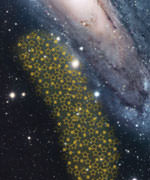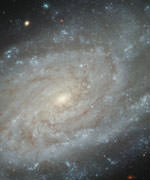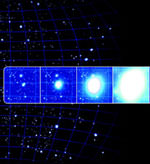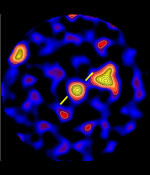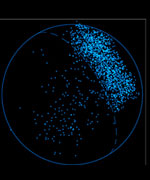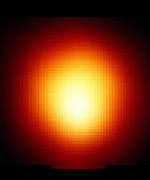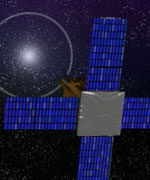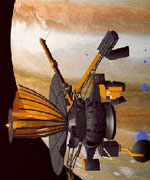
Image credit: NASA/JPL
We’re only days away until Galileo’s final plunge into Jupiter on September 21. Nearly out of fuel, the spacecraft was put onto a collision course with Jupiter to prevent it from accidentally crashing into Europa and potentially contaminating it with Earth-based bacteria. The entry point on Jupiter will be 1/4 of a degree south of its equator and it will strike the planet at 174,000 km/h – obviously it’ll be destroyed almost instantly. Scientists hope to retrieve every piece of data they can, but the radiation will intensify to immense levels as the spacecraft nears the planet, so it might not be possible.
In the end, the Galileo spacecraft will get a taste of Jupiter before taking a final plunge into the planet’s crushing atmosphere, ending the mission on Sunday, Sept. 21. The team expects the spacecraft to transmit a few hours of science data in real time leading up to impact.
The spacecraft has been purposely put on a collision course with Jupiter to eliminate any chance of an unwanted impact between the spacecraft and Jupiter’s moon Europa, which Galileo discovered is likely to have a subsurface ocean. The long-planned impact is necessary now that the onboard propellant is nearly depleted.
Without propellant, the spacecraft would not be able to point its antenna toward Earth or adjust its trajectory, so controlling the spacecraft would no longer be possible.
“It has been a fabulous mission for planetary science, and it is hard to see it come to an end,” said Dr. Claudia Alexander, Galileo project manager at NASA’s Jet Propulsion Laboratory, Pasadena, Calif. “After traversing almost 3 billion miles and being our watchful eyes and ears around Jupiter, we’re keeping our fingers crossed that, even in its final hour, Galileo will still give us new information about Jupiter’s environment.”
Although scientists are hopeful to get every bit of data back for analysis, the likelihood of getting anything is unknown because the spacecraft has already endured more than four times the cumulative dose of harmful jovian radiation it was designed to withstand. The spacecraft will enter an especially high-radiation region again as it approaches Jupiter.
Launched in the cargo bay of Space Shuttle Atlantis in 1989, the mission has produced a string of discoveries while circling the solar system’s largest planet, Jupiter, 34 times. Galileo was the first mission to measure Jupiter’s atmosphere directly with a descent probe and the first to conduct long-term observations of the jovian system from orbit.
It found evidence of subsurface liquid layers of salt water on Europa, Ganymede and Callisto and it examined a diversity of volcanic activity on Io. Galileo is the first spacecraft to fly by an asteroid and the first to discover a moon of an asteroid.
The prime mission ended six years ago, after two years of orbiting Jupiter. NASA extended the mission three times to continue taking advantage of Galileo’s unique capabilities for accomplishing valuable science. The mission was possible because it drew its power from two long-lasting radioisotope thermoelectric generators provided by the Department of Energy.
From launch to impact, the spacecraft has traveled 4,631,778,000 kilometers (about 2.8 billion miles).
Its entry point into the giant planet’s atmosphere is about 1/4 degree south of Jupiter’s equator. If there were observers floating along at the cloud tops, they would see Galileo streaming in from a point about 22 degrees above the local horizon. Streaming in could also be described as screaming in, as the speed of the craft relative to those observers would be 48.2 kilometers per second (nearly 108,000 miles per hour). That is the equivalent of traveling from Los Angeles to New York City in 82 seconds. In comparison, the Galileo atmospheric probe, aerodynamically designed to slow down when entering, and parachute gently through the clouds, first reached the atmosphere at a slightly more modest 47.6 kilometers per second (106,500 miles per hour).
“This is a very exciting time for us as we draw to a close on this historic mission and look back at its science discoveries. Galileo taught us so much about Jupiter but there is still much to be learned, and for that we look with promise to future missions,” said Dr. Charles Elachi, director of JPL.
Original Source: NASA/JPL News Release

